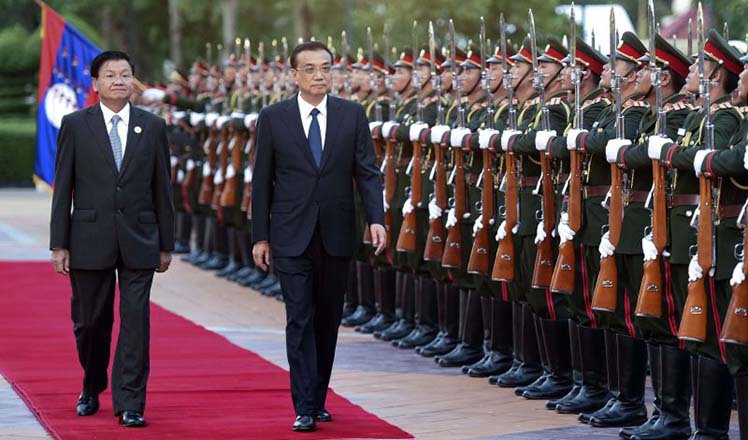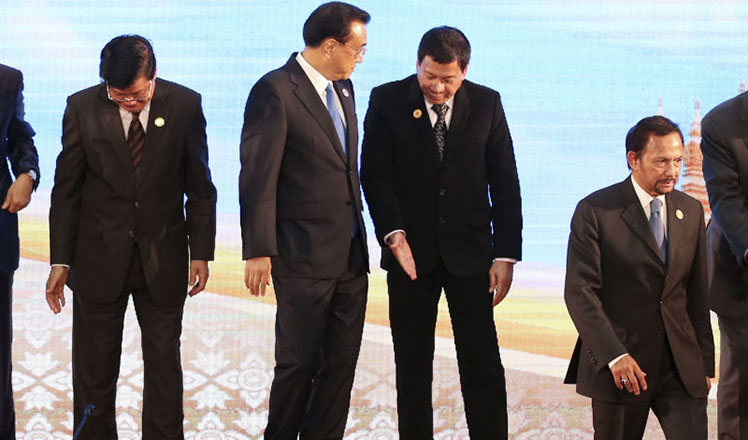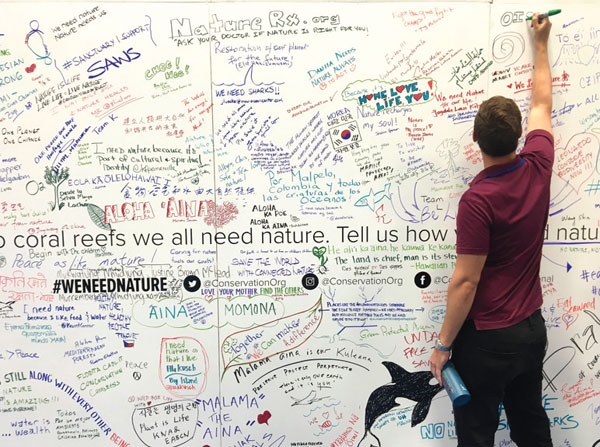8,000 conservationists convene in Hawaii
Updated: 2016-09-09 11:26
By Yan Dongjie(China Daily USA)
|
|||||||||
|
A visitor signs the wall of the Hawaii Convention Center, where IUCN World Convention Congress was being held from Sept 1 to 10. Yan Dongjie / For China Daily |
So far September in the Aloha State has been all about protecting the environment.
About 8,000 people from more than 180 countries have gathered in Honolulu Sept 1 to 10 to discuss environmental protection and sustainable development challenges at the 6th World Conservation Congress of the International Union for Conservation of Nature (IUCN).
About 300 Chinese government officials, academics, researchers and representatives from environmental protection groups attended the congress, joining what's being called its largest attendance yet, according to Guo Yufu, a director from China's State Forestry Administration.
"We'd like to highlight China's progress in environmental protection in recent years and our determination to build an eco-civilization - respecting, adapting to and conserving nature in meeting our social and economic needs," said Guo.
With 1,300 both governmental and private organizations as members, the IUCN has grown into the world's largest and most diverse environmental network since its creation in 1948.
Representing China as a member country, the Ministry of Foreign Affairs joined the IUCN in 1996. Since then more than 30 organizations in China have also joined, according to Hou Bo, a staff member of IUCN's China office.
The convention's theme this year is Planet at the Crossroads.
On Sept 4, it was announced that the giant panda would be downgraded from Endangered to Vulnerable on the IUCN's' Red List of Threatened Species.
[The giant panda] "population has grown due to effective forest protection and reforestation," the IUCN announcement read. "The improved status confirms that the Chinese government's efforts to conserve this species are effective."
In addition, the Tibetan antelope was moved from Endangered to Near Threatened, downgrading two notches, as its population "is currently likely to be between 100,000 and 150,000", virtually double the estimated 65,000-72,500 of the 1980s and early '90s.
"I never imagined that the Chinese government was making such an effort to protect the environment, biological diversity, and habitats," said Wang Zhenyao, president of China Global Philanthropy Institute, who attended IUCN congress as well as the earlier third East-West Sustainability Summit, an annual global meeting led by Chinese philanthropists concerned with the environment.
"Decades ago, earning a living was people's biggest concern," said Wang. "As the economy develops, people start to pay more attention to the environment, caring about the air, water, and soil, which our decadents will be living with."
- Three women planning 'imminent' attacks arrested in France: minister
- China, Britain vow to deepen military exchanges, mutual trust
- British parliament to debate second Brexit referendum petition
- Chinese women find their way through the glass ceiling
- Rousseff leaves presidential residence in salutation
- Thousands of Chinese rally in Paris to call for 'security for all'

 Sights and sounds of Premier Li's visit to Laos
Sights and sounds of Premier Li's visit to Laos
 Yao Ming and Class of 2016 receive Hall of Fame jackets
Yao Ming and Class of 2016 receive Hall of Fame jackets
 Bullet train attendants strut new look in Xi'an
Bullet train attendants strut new look in Xi'an
 Ten photos from around China: Sept 2 - 8
Ten photos from around China: Sept 2 - 8
 Turning mud into work of art
Turning mud into work of art
 Unforgettable moments of Premier Li at ASEAN meeting
Unforgettable moments of Premier Li at ASEAN meeting
 Six policy signals China sent at G20 Summit
Six policy signals China sent at G20 Summit
 'First Lady table ware' a hit in Hangzhou
'First Lady table ware' a hit in Hangzhou
Most Viewed
Editor's Picks

|

|

|

|

|

|
Today's Top News
Trump outlines anti-terror plan, proposing extreme vetting for immigrants
Phelps puts spotlight on cupping
US launches airstrikes against IS targets in Libya's Sirte
Ministry slams US-Korean THAAD deployment
Two police officers shot at protest in Dallas
Abe's blame game reveals his policies failing to get results
Ending wildlife trafficking must be policy priority in Asia
Effects of supply-side reform take time to be seen
US Weekly

|

|










